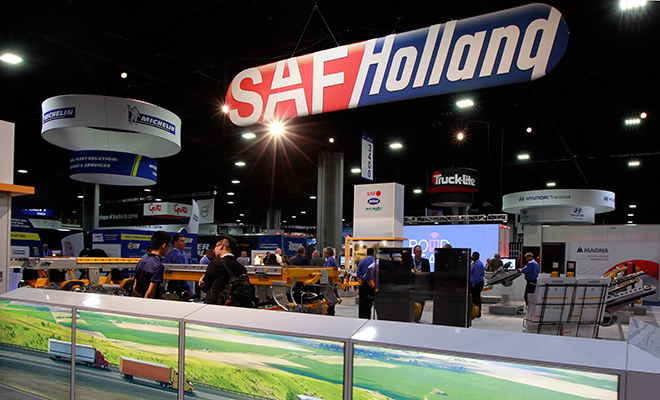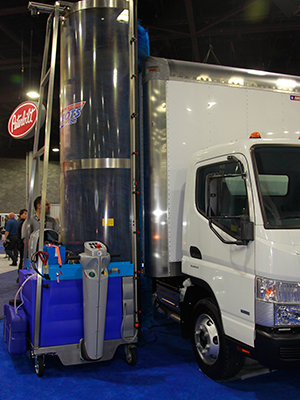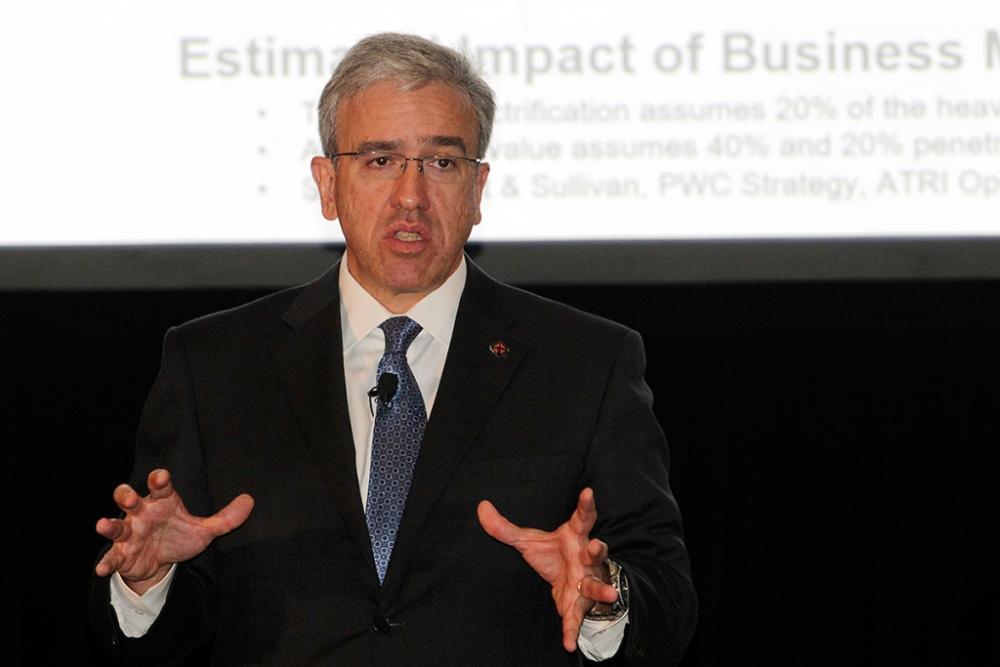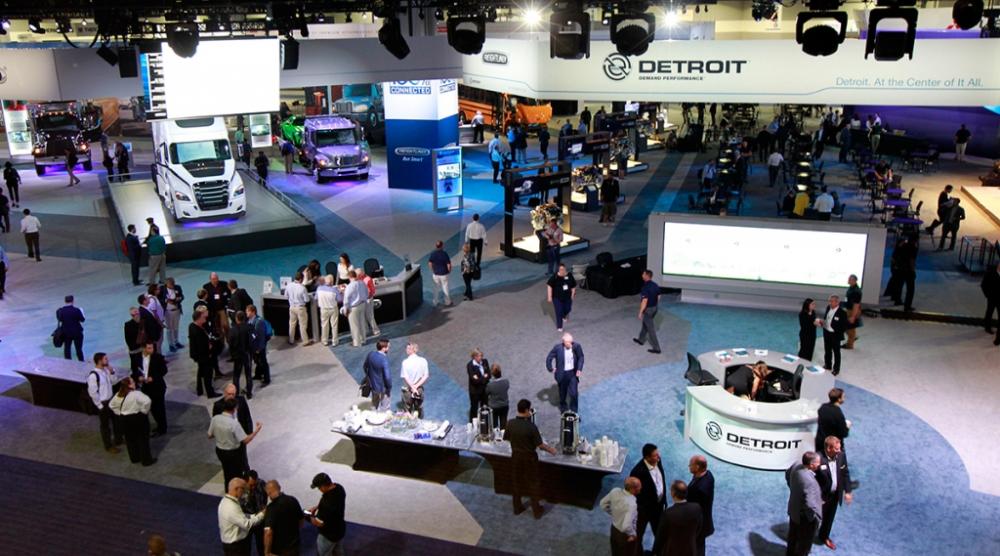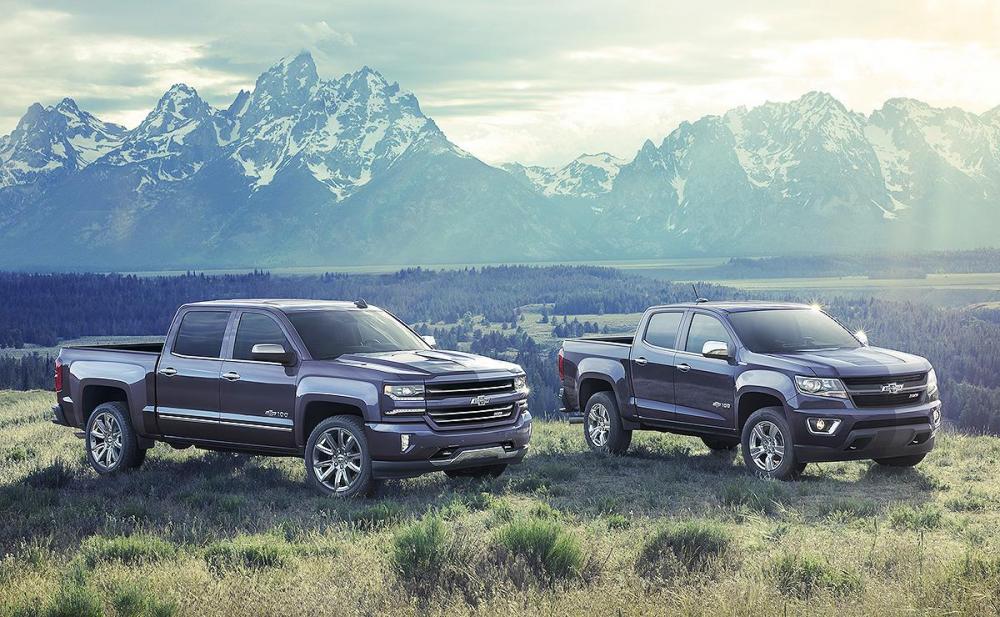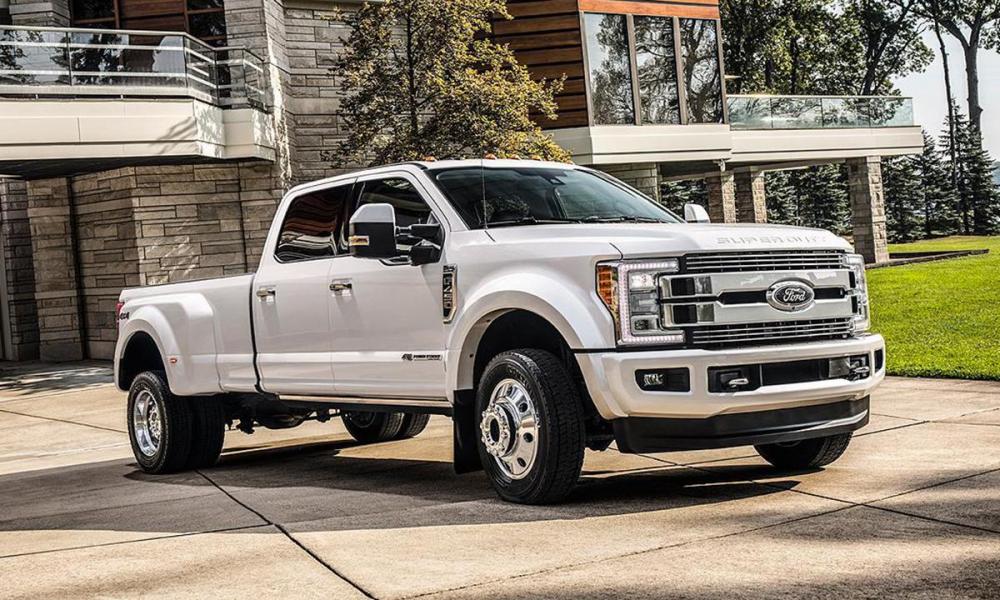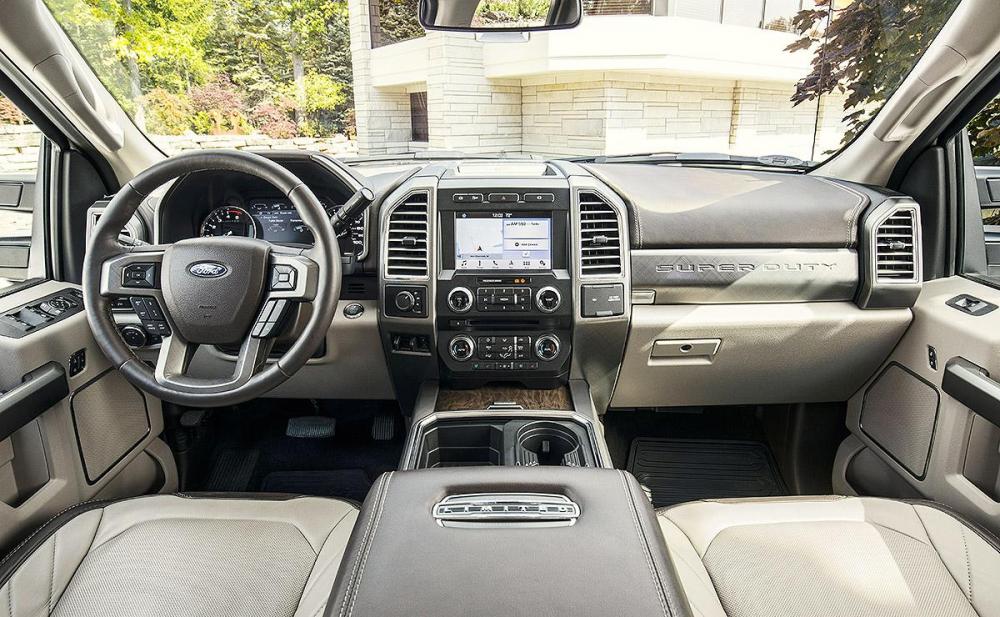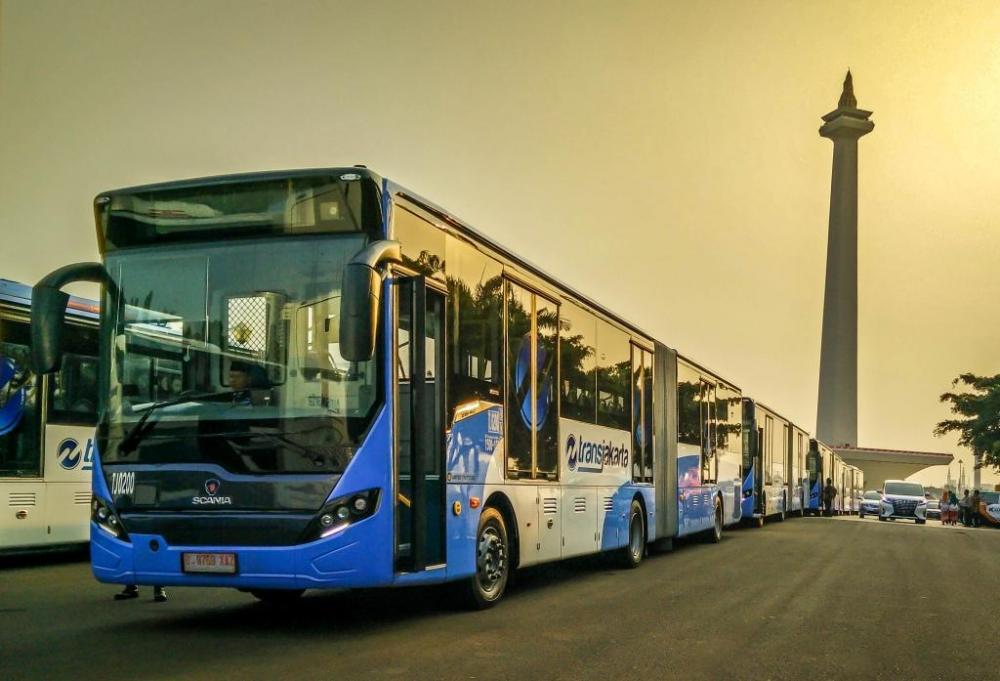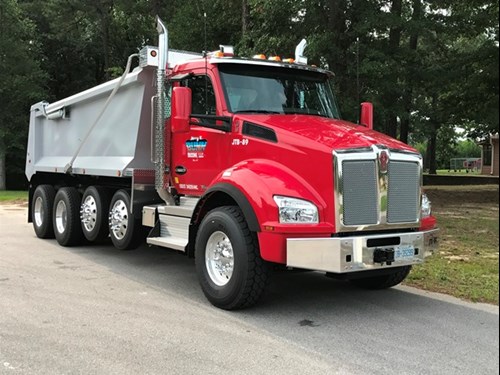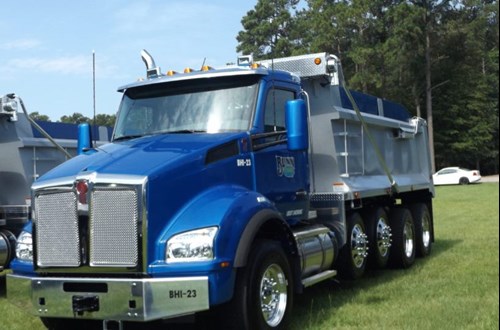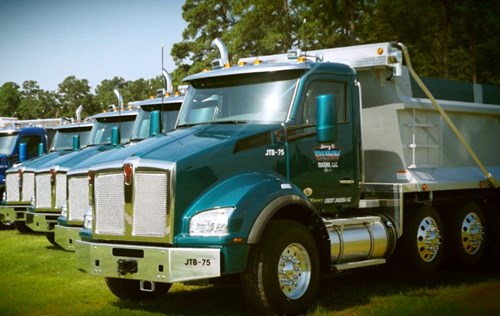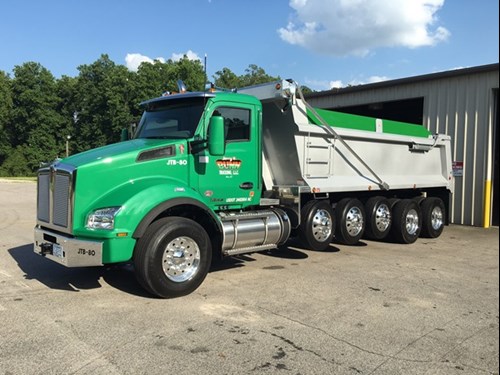
kscarbel2
Moderator-
Posts
18,876 -
Joined
-
Days Won
114
Content Type
Profiles
Forums
Gallery
Events
Blogs
BMT Wiki
Collections
Store
Everything posted by kscarbel2
-
Transport Topics / September 28, 2017 ATLANTA — Truck-leasing provider Ryder System Inc. has signed an exclusive agreement with Aperia Technologies to implement automatic tire inflation as a standard specification across its heavy-duty rental fleet. Through that partnership, Ryder will equip all new heavy-duty rental trucks with Aperia’s Halo Tire Inflator systems, the companies announced Sept. 27 during a joint press conference here at the North American Commercial Vehicle Show. Ryder already has an advanced tire-pressure management program for its trucks, but “once that product leaves our possession, tire inflation becomes a major issue,” said Scott Perry, Ryder’s chief technology and procurement officer. Inadequate tire pressure can weaken fuel efficiency and lead to tire failures, which are a major source of downtime for fleet customers and a drain on Ryder’s service operations, he said. “This is a product and a relationship that we think is going to have a significant impact on our overall operations and cost and our value proposition to our customers,” Perry said. Josh Carter, co-founder and CEO of Aperia, said the Halo system can boost fuel efficiency by 1-2% and extend tire life by 10-15% while improving safety and vehicle uptime. Halo is a bolt-on system that uses the wheel’s rotational motion to pump and maintain ideal tire pressure. The product’s design enables it to be installed on both tractors and trailers, unlike traditional automatic inflation systems that route air lines through the axles and are focused mostly on the trailer. “We’re really excited to be able to bring the value to other wheel positions for our customers,” Carter said. Perry said Ryder already has installed the Halo system on “hundreds” of rental trucks and will continue to deploy the system rapidly as it replenishes its fleet. Beyond its rental trucks, Ryder said it will make the Halo system the preferred tire inflation option for its long-term lease customers. Ryder also plans to offer the Halo system through its SelectCare service, where Ryder provides full-service maintenance and support for customer-owned vehicles. Perry said the Halo units are simple to maintain. “That’s really the beauty of this product,” he said. “This is as close to a zero-maintenance product as you can get once it’s installed, and that was a key driver of the decision-making process for us.” .
-
SAF-Holland unveils new lift axle, retrofit for lighted fifth wheel
kscarbel2 replied to kscarbel2's topic in Trucking News
SAF-Holland Displays Suspension System, Retrofit Kit Transport Topics / September 28, 2017 ATLANTA — International Tier 1 supplier SAF-Holland introduced a new lift-axle suspension system for heavy-duty trucks and a retrofit kit for its fifth-wheel coupling system. SAF executives also made a presentation for donating almost $74,080 to the Wyakin Foundation of Boise, Idaho, which helps prepare U.S. veterans for civilian careers. The company’s U.S. operations are based in Muskegon, Mich., and management made the announcements Sept. 27 here at the North American Commercial Vehicle Show. The parent company has headquarters in Luxembourg and its three major North American brands are SAF, Holland and Neway. The new product is the large-capacity Neway LSZ auxiliary, steerable, lift-axle suspension system for vocational trucks that often haul heavy loads. The system has an 18.3-inch package size as part of a design that is up to eight inches shorter than comparable lift axles. The company said this allows LSZ to fit where other lift axles cannot, thereby providing extra frame rail space for other uses. “If the LSZ is spec’d on a new truck, it may reduce the truck’s overall wheelbase to provide extra maneuverability,” said Jason Heath, a Neway product manager. Lift axles help heavy-haul trucks comply with the bridge formula for weight distribution. When a truck is fully loaded, more weight-bearing wheels are lowered to the pavement. When the truck is empty, the wheels are lifted to improve fuel mileage. Heath said the LSZ lifts quickly and reduces bouncing. Dump trucks, refuse haulers, concrete mixers and pumpers, logging trucks and cranes are among the potential customers, he said. The retrofit kit is for Holland’s electronic lock indicator, ELI-te, to be added to FW35 series fifth wheels. ELI-te is designed to make sure a trailer’s king pin is securely fastened to the tractor’s fifth wheel. Tom Bronz, Holland’s director of aftermarket sales, said the retrofit kit takes about 45 to 90 minutes per tractor to install. The job entails modifications to the existing fifth wheel’s top plate. “The lights make it easy for drivers to positively confirm that they have coupled correctly, and warn them if they have not. It’s a new generation of safety,” Bronz said. Regarding the charitable donation, Carl Mesker, vice president for SAF-Holland aftermarket, said, “The Wyakin Foundation is an outstanding organization where a large percentage of every dollar counts toward helping veterans transition into our industry. We need more great people in the heavy duty industry and the Wyakin Foundation can be a resource for every supplier in this industry. We are excited about the success of our promotion, and appreciate the outstanding participation from our HDA Truck Pride members.” SAF-Holland CEO Detlef Borghardt was also at the presentation. He said the corporation’s major customers are trailer makers, providing 60% of revenue; truck makers, 15%; and aftermarket, 25% of sales. Global 2016 sales for the company were the equivalent of $1.15 billion. . -
New Wash-Bots to Enhance Cleaning Experience
kscarbel2 replied to kscarbel2's topic in Trucking News
. -
Transport Topics / September 28, 2017 ATLANTA — An enhanced machine for washing trailers and buses was showcased at the North American Commercial Vehicle Show. Bitimec Wash-Bots demonstrated its new 626 EZ model, which is designed to be a faster tool for attending to up to 30 buses or trailers in one charge of the batteries. The battery operated machine is relatively quiet, and emission-free. Also, it is ideal for uses both indoors or outdoors. With an elegant, tall look, and dynamic blue bristles adequate for a variety of vehicles, the machines are expected to facilitate the cleaning experience at hubs and warehouses. “It’ll do the job in about six to eight minutes. One operator can wash about 30 to 40 trucks in one shift. And we have people doing that. We have people doing that at different companies,” Bruno Albanesi, president at Bitimec International Inc., told Transport Topics on Sept. 27. “It’s really a handy machine for these guys to have,” he added, as a colleague demonstrated the machine inside the expansive convention floor. Several firms have chosen the new, state-of-the-art wash-bots. These include Texas-based Keg 1, Divine Charter of Phoenix, Ariz., and the distributor Indiana Beverage. .
-
Transport Topics / September 27, 2017 ATLANTA — Trailers are on the verge of delivering more than just freight. A bevy of additional sensors linked to various components are coming to trailers to relay increasing amounts of data, suppliers said. The suppliers made their comments during a symposium hosted by Utility Trailer Manufacturing Co. at the inaugural North American Commercial Vehicle Show here Sept. 27. “The demand for data is simply everywhere. In the past, data was collected on the exception basis when something [unusual] was going on. We feel data will be collected continuously in the future,” said Bendix Commercial Vehicle Systems CEO Berend Bracht. With the near certainty of truck platoons before too long, knowing exactly what the braking system is not just on the various trucks but also the trailers seeking to join up is crucial, he said. The important question to answer is, “Who benefits from the information, and how quick do they need to get it?” said David Kiefer, director of sales and marketing and product management at Carrier Transicold. With so much data available, the key is converting it to something useful for decision making, he said. “If you have a pending issue where something is going to break or you are going to lose your [refrigerated load], you would want to do something in real time,” Kiefer said. “And if you have something in between, maybe it goes to dispatch and they can filter it and decide if it needs to go to the driver.” The ideal state for a fleet, he suggested, was to have all the systems on the trailer “talking,” then receive a single bill for all of the airtime, and worst case go to a website for information and best case have information integrated into your back office system. .
-
Transport Topics / September 27, 2017 ATLANTA — Disruptions of supply chain operations are coming and will shake up the trucking industry from fleets to suppliers, an executive with one truck maker said, adding it was time for the industry to get “paranoid.” “The industry will really look different, and we better all be prepared for that because there is change coming,” said Persio Lisboa, chief operating officer at Navistar International Corp. Lisboa made the comments while delivering the keynote address at the annual Heavy Duty Manufacturers Association Breakfast and Briefing, which was part of the inaugural North American Commercial Vehicle Show here Sept. 27. Driving that disruptive change is the need to keep up with customers’ expectations of instant information and order delivery — or close to it, he said, adding those factors are reshaping the supply chain. Plus, there’s the need to reduce unplanned down time, increase driver safety and maximize asset utilization. To help with that, the industry has the emerging power of big data — built on connectivity — behind it, and that can improve supply chain operations and fleet performance, Lisboa said. Lisboa told the story of how, using “cluster methodology,” Navistar was able to gather data through its connected vehicle services application from participating carriers clustered in a geographic region. Navistar analyzed the information and compared the performance of the similarly operating carriers. One carrier in the group stood out as operating about three times less efficiently, he said. Navistar contacted that carrier and ultimately learned the carrier was using a spec that had been part of the way it operated for a long time, but it was causing the fuel efficiency of its trucks to fall. The company pointed that out to the carrier, and they changed the spec and improved its fuel efficiency. Meanwhile, connected vehicles will be the “backbone” of the digital supply chain, he said. Yet, about 70% of the trucks on the road don’t have telematics devices. “How do we reach them?” he asked. “That is a major opportunity for disruption” and for digital load-matching companies “to jump into our sector.” Navistar monitors about 350,000 trucks using its OnCommand Connection and stores 8.8 million miles of data each day, and can identify where and when 1.3 million gallons of fuel are consumed in those trucks, Lisboa said. As it turns out, Friday is the day with the highest fuel consumption, according to Navistar data. In addition, the federal government needs to pass regulations encouraging the use of automated trucks to make the roads safer. “We will see dedicated vehicles operating ramp-to-ramp,” he said. “Call it disruption, but in the end it is just productivity — it is just taking waste out of the system,” Lisboa said. The question is who is going to be in the forefront of the coming changes, he said.
-
FlowBelow Adds Quick-Release Option for Fairings
kscarbel2 replied to kscarbel2's topic in Trucking News
-
Transport Topics / September 27, 2017 ATLANTA — FlowBelow Aero Inc. announced a quick-release fairing option for its flagship Tractor AeroKit system. The company made its announcement at the inaugural North American Commercial Vehicle Show here Sept. 27. The quick-release mounting system allows the driver of the truck to remove the between-wheel fairings — intended to boost fuel efficiency — easily in seconds and without tools when installing tire chains, for example, according to the company. The Tractor AeroKit maximizes the aerodynamic performance of the company’s wheel covers by also controlling the airflow between and behind the wheels, according to FlowBelow. “By enhancing our AeroKit with quick-release fairings we are targeting customers that desperately want to achieve the maximum fuel savings possible without creating extra work for their mechanics or drivers,” FlowBelow’s founder and CEO Josh Butler said in a statement. The system is available through all Freightliner, Kenworth and Peterbilt dealers.
-
Inaugural NACV Draws Top Fleet Execs, Praise Transport Topics / September 28, 2017 ATLANTA — North American truck makers and their customers wrapped up the first of a new option for shopping for and even buying Class 8s, with manufacturers producing large, elaborate displays for a limited number of high-probability buyers: top fleet executives. The North American Commercial Vehicle Show ran here Sept. 25-28 for nearly 10,000 attendees who traipsed across 379,300 square feet of exhibits in the Georgia World Congress Center to check out what’s available in the truck market today and what’s planned for in the coming years. Five of the seven heavy-duty truck brands were the stars, but there were also top-tier suppliers to answer questions about their products. Trucking executives who spoke to Transport Topics said there was more shopping than buying, but shopping of consequence. U.S. Xpress Enterprises is preparing for the truckload carrier’s 2018 truck buy, some 1,500 to 2,000 tractors. “I’m in the middle of negotiations,” said Max Fuller, the company’s chairman. “We’ll complete this in the next three-to-six weeks,” he said, adding that his two-day visit was “extremely useful.” Fuller said he visited with truck, engine, transmission and tire makers. Then he looked into air disc brakes. “It’s a good place to compare products,” he said. Marten Transport Chairman and CEO Randolph Marten said, “It reminded me of the Hanover [Germany] show last year, where it was all set up with everything they made.” He said he did not go to buy vehicles, but that there was time for detailed conversations with supplier executives. In just one day there, Marten said, he met with three truck makers, major producers of refrigeration units Thermo King and Carrier Transicold, and some others. His Mondovi, Wis.-based company is the fifth-largest refrigerated carrier in North America. “If you wanted to know something, you could get it answered,” Marten said. Bill Reed, CEO of Skyline Transportation in Knoxville, Tenn., also attended for one day and said he shopped for trucks that emphasize driver amenities. He said he was “impressed” with the event and that it offers benefits for both sides. “I could do a lot of comparison shopping, and the OEMs had all of their customers in one place,” Reed said, referring to original equipment manufacturers. He did not make any purchases during the show, but Reed said he’ll be buying trucks during the first quarter of 2018 and the NACV visit will help with the process. NACV is scheduled to run in odd-numbered years and was set up as an alternative to the larger, older Mid-America Trucking Show that convenes annually in Louisville, Ky. “For a first edition, we’re happy but not satisfied. We know there are improvements to be made,” said Joe Glionna, president of NewCom Business Media, the Canadian half of the joint venture that created the NACV. The other partner is Germany’s Deutsche Messe, with U.S. arm Hannover Fairs. The show had 452 exhibitors who occupied 441 booth spaces. Some corporations with multiple brands put more than one exhibit in a booth. Glionna said he did not quite get the 10,000 visitors that he was hoping for, but “came close.” Final attendance figures will be published Oct. 2, he said. “We are extremely happy with the turnout of the show,” said Jeff Sass, senior vice president of sales and marketing for Navistar Inc. “We had the right customers there, heavy booth traffic and were proud to be a part of the inaugural year of this show. We’re already looking forward to 2019.” “The goal of the show, I think, is really excellent, in terms of connecting with fleets and connecting with customers,” said Jon Morrison, president of Wabco Holdings’ Americas division. Except for a new Navistar vocational model, all of the trucks on display had been introduced before the show, but Glionna said he expects that to change. “Some of the plans for new trucks are three or four years in the making,” so synchronization with 2017 NACV was not possible, he said. “But two years from now we’re definitely going to see truck and innovation launches,” Glionna said. As for innovation, there was consistency on what will come: autonomous, connected and electric vehicles. Connectivity has made the most progress so far, with all truck makers emphasizing in-truck telematics as one of the most important tools for not just preventive maintenance, but predictive fixes and improvements. Freightliner, Mack, Navistar, Volvo and Western Star all mentioned it. Electric vehicles are coming, all manufacturers said, but Class 8 highway tractors might take the longest. Medium-duty trucks, such as Class 6 or Class 7 models mentioned by Navistar, seem more likely to come first. But a Daimler executive said his company would like to one day make and sell a “Cascadia-E” electric tractor. Manufacturers said workable battery packs are becoming less expensive and less bulky over time due to much research. The autonomous angle was couched in terms of systems that assist drivers, rather than replace them. .
-
Cummins Eyes Eventual Expansion in Medium-Duty Market
kscarbel2 replied to kscarbel2's topic in Trucking News
https://www.bigmacktrucks.com/topic/35823-ford-re-launches-f-4000-at-brazil’s-agrishow/ http://www.fordcaminhoes.com.br/serie-f/f-4000 https://www.bigmacktrucks.com/topic/36835-ford’s-f-4000-to-return-in-september/ -
Ford plant in Wales to lose JLR engine business earlier than expected Reuters / September 28, 2017 LONDON -- Jaguar Land Rover (JLR) will stop sourcing gasoline engines from Ford Motor's plant in Bridgend, Wales, UK and end its current contract earlier than expected in 2020, creating uncertainty over 750 jobs. "We have informed our unions that Jaguar Land Rover intends to end our petrol engine supply arrangement slightly earlier than expected in late 2020," Ford said in a statement. "Given our long-established and successful relationship in the delivery of world-class engines, this is disappointing news for the Ford Bridgend engine plant." JLR had decided to end its long-standing relationship with the plant, after the current contract expires three months earlier than planned in September 2020, a source close to the arrangements said. Around 750 workers, about half of the plant's total, are dedicated to JLR production, the source said. Ford said it would "continue to look at other high technology opportunities for Bridgend in the future." JLR, which Ford sold to Tata Motors in 2008, opened a new engine plant in England's West Midlands in 2014, and in 2015 announced a plan to double its size, taking total investment to about 1 billion pounds ($1.3 billion). The company said that in line with its contract it had served the required three years notice to Ford for the supply of the six- and eight-cylinder gasoline engines from its Bridgend plant. "Ford has been, and remains, an important strategic supplier to Jaguar Land Rover under an agreement which was negotiated to support our business until the end of the decade," it said. The announcement is another blow to the Welsh plant, which is already facing potential job cuts as Ford grapples with the aftermath of Brexit and slowing growth in Europe.
-
Chevrolet celebrates 100 years of making pickups with special edition Silverado and Colorado Automotive News / September 28, 2017 DALLAS -- Chevrolet is adding two special edition trucks to its lineup this fall to commemorate the 100th anniversary of the first Chevy pickup. The Centennial Edition of the full-size Silverado arrives in October. It will be joined in November by the Centennial Edition of the Colorado midsize pickup. Both are premium trucks. The Silverado Centennial Edition is available only on crew cab trucks ordered with the LTZ Z71 trim package. The Colorado Centennial Edition is available on extended cab or crew cab pickups ordered with the Z71 trim package. Both trucks, shown for the first time Thursday at a media preview at the State Fair of Texas, sport retro-themed Chevrolet "bow tie" badges, larger wheels, spray-in bedliners, special chrome trim, a custom Centennial Blue paint job and several other cosmetic tweaks. Chevrolet's first pickups weren't generally available to the public. They were cobbled together from car parts and used to lug heavy equipment and parts around plants, but by 1918, Chevrolet realized there was a market for such a vehicle and launched the 490 Light Delivery -- which looked like a car with the rear half of the body removed. Since 1918, Chevrolet has sold more than 85 million pickups. The Centennial Edition Silverado is likely the last special edition of the current-generation pickup, which went on sale in 2013 as a 2014 model. A lighter-weight Silverado, to be built using General Motors' mixed-material manufacturing system that mixes steel, aluminum and magnesium, is expected to debut next year as a 2019 model. GM gave its new manufacturing system a test run on the Cadillac CT6 sedan, which, when it debuted, was not only the lightest car in the full-size sedan class but also in the midsize class. Ford whacked as much as 600 pounds off the F-150 when it switched to an aluminum body in late 2014. Since then, Ford has increased its aluminum-bodied offerings to include the Super Duty pickups and the Ford Expedition and Lincoln Navigator SUVs. The debut of the Centennial Edition pickups kicks off a celebration of Chevy trucks that is scheduled to conclude Dec. 16 at the Texas Motor Speedway. "Both vehicles offer our most enthusiastic fans a way to demonstrate their love for Chevy Trucks and celebrate the Chevy Trucks Centennial with us," said Chevrolet Trucks director of exterior design Rich Scheer. Photo gallery - http://www.autonews.com/article/20170928/RETAIL03/170929788/chevy-silverado-centennial-variant-texas .
-
Ford pushes into the $100,000 range with new F-450 Limited Automotive News / September 28, 2017 The $100,000 pickup is almost here. For 2018, Ford is adding a new top-of-the-line model, the F-450 Limited 4x4. The starting price, including $1,295 for shipping, is $87,100. Ford says customers who check every available option will push the price to $94,455. Add in sales taxes and title fees, and most buyers are looking at a six-figure purchase price. And that's OK with Ford. "We still haven't found the ceiling for luxury trucks," said Ford spokesman Mike Levine. The truck's interior is even more opulent than the King Ranch and Platinum, Ford's two luxury pickups. The F-450 Limited features custom camelback leather two-tone seats, a suede headliner and stitched leather on the steering wheel and instrument panel. The interior is bedecked with hand-finished dark ash wood trim. But the F-450 Limited isn't just about leather seats, an advanced infotainment system and a full menu of safety equipment. Ford says it can tow up to 15 tons. The truck is powered by a 6.7-liter Power Stroke turbodiesel V-8 mated to a six-speed automatic that drives all four wheels. Dual rear wheels are optional. "Super Duty Limited is the most luxurious and advanced heavy-duty pickup truck ever created by Ford for accomplished buyers with appetites for the high life and hard-earned dollars to match," Todd Eckert, Ford truck group marketing manager, said in a statement. Ford plans to unveil the F-450 Limited on Thursday at a press preview at the State Fair of Texas in Dallas. The fair, ground zero in the pickup marketing wars, is a venue where automakers often up the ante in towing, torque, horsepower and luxury models. The truck display at the fair, which opens to the public Friday and runs through Oct. 22, is like a giant amusement park for truck buyers. It is filled with interactive events, outsized displays, engineers, product information specialists and demonstrations of towing and hauling capabilities. Last year, more than 2.4 million people attended the fair. Photo gallery - http://www.autonews.com/article/20170928/RETAIL03/170929804/ford-fseries-450limited-pickup .
-
Scania Group Press Release / September 27, 2017 Over the years Scania’s new construction trucks have been tested in a multitude of tough and unusual environments, but nowhere has been more challenging than an extinct volcano. Experienced field-test driver Uwe Sommer is putting a new Scania construction truck through some challenging paces. Sommer works in the forests north of Koblenz, Germany, maintaining forest tracks on behalf of transport company Forstunternehmen Krobbach, based in nearby Melsbach. Part of his work involves venturing into an extinct volcano in the Eifel mountain range, where he loads crushed lava that will be used for strengthening and improving a forest pathway that lies ten kilometres away. Within a typical hour Sommer and the truck must master three completely different conditions and surfaces: firstly, slow progress on the muddy lava slag in the 10,000-year-old volcano; next, travel at full speed along a newly paved country road; and finally, slow progress again to negotiate the muddy and rutted forest pathway. Road conditions are normally bad in the forest, and the whole operation can be limited during severe rainfall, when the trucks get stuck in the mud. “It takes a lot of experience,” Sommer explains. “You should know the different construction trucks, and how they react. And you also need experience of the surfaces on which you drive, since they all differ so much.” Forstunternehmen Krobbach was founded 45 years ago by Rudi Krobbach, a postman, and his wife, Edith. Krobbach wanted a sideline, so he began growing and recycling Christmas trees. Over the years the business developed into a more diverse forestry construction business, which soon meant a fleet of construction trucks were required. The Krobbach fleet consists of more than 40 vehicles The company won contracts with large companies and governmental institutions such as the Kevag, German Rail, the Süwag and various forestry departments and municipalities throughout Rhineland-Palatinate and North Rhine-Westphalia. Today the Krobbach fleet consists of more than 40 vehicles, from trucks to special forestry equipment, excavators and wood choppers. Now the new Scania truck has joined the fleet. Uwe Sommer has been driving construction trucks for 30 years, and he’s impressed with the new-generation Scania. “The overall driving comfort of this new truck is fantastic,” he says. “I was always happy with the comfort of Scania trucks, but this one is outstanding; it drives beautifully straight.” Sven Wittke, Transport Manager at Forstunternehmen Krobbach, is a genuine Scania fan. He talks for hours about the gear changing and the interior of the new truck, but has even more to say about the partnership his company feels that it has with Scania. “We are always shown the various options and available configurations by Scania” “When we want to order a new vehicle, a sales rep usually visits us,” Wittke explains. “Together we review the company’s needs. In most cases we know what we want: high reliability, a lot of vehicle uptime and a good support service. We are always shown the various options and available configurations by Scania. We can have different wheel bases and axles, as well as different gearboxes, engines and cabs. In the end we always get exactly the right specification for our business.” The field-test truck, an R 450 LB8x4 tipper with a short cab and low roof, has been in service for Forstunternehmen Krobbach since spring 2016. “I know from the other construction trucks we have that you can trust Scania a thousand percent,” says Wittke. “And it’s the same with this field-test vehicle. Since we work and drive so much in forests, the vehicles must endure a lot. But we have never had any major damage, just the normal wear and tear. I think you can’t compare Scania with any other truck manufacturer, as no other manufacturer meets the robustness of Scania.” While the field-test truck is loaded with more tonnes of crushed lava, Sommer once again enjoys all the new features in his cab. “The leather steering wheel has a really nice grip,” he says. “The switches are clearly arranged and can be operated easily and quickly. The overview from this vehicle has been vastly improved compared with its predecessor – it’s wider and you can see more, and the blind spots have been reduced. I just love it.” .
-
Scania Group Press Release / September 27, 2017 Scania today joins the Global Industry Partnership on Soot-Free Clean Bus Fleets with a commitment to, by 2018, provide modern soot-free buses to 20 major cities in Africa, Asia, Latin America and Australia. “To tackle the challenge of poor air quality and climate change, Scania is proud to offer clean bus solutions operating at lower cost than today’s conventional diesel operations,” says Karin Rådström, Head of Buses and Coaches at Scania. Black carbon is a significant component of fine particulate matter (PM2.5) outdoor air pollution, which has been linked to a series of adverse health effects, in particular premature mortality. Recent scientific research also indicates that black carbon plays an important role in climate change. Scania today manufactures and sells soot-free buses that effectively produce up to 99 percent fewer black carbon emissions than older diesel engine technology. However, of all buses sold in the world today, less than one-fifth have soot-free engines. “There is a growing opportunity to create economic, environmental, and human health benefits by transitioning the highest emitting and oldest engines in the global urban bus fleet to the cleanest fuels and engines available,” states the Global Industry Partnership. The transition to soot-free buses is an initiative led by the International Council on Clean Transportation, ICCT, and UN Environment in cooperation with the C40 Cities Climate Leadership Group and the Centro Mario Molina – Chile. The targeted cities are Abidjan, Accra, Addis Ababa, Bangkok, Bogotá, Buenos Aires, Casablanca, Dar es Salaam, Dhaka, Istanbul, Jakarta, Johannesburg, Lagos, Lima, Manila, Mexico City, Nairobi, Santiago, São Paulo, and Sydney. Some of these cities have already committed themselves to start procuring cleaner buses and Scania presently delivers soot-free buses to several of the targeted countries. The cities will, in turn, provide fuel for engines that meet the Euro 6 or US 2010 emission standards, including diesel fuel with less than 10 ppm sulphur and other low-carbon alternative fuels, such as biodiesel, gas and ethanol. Scania can provide buses for all these technologies. In 2016, Scania sold 2,583 soot-free buses (Euro 6), representing 30.5 % of the total bus sales. This transition requires the commitment and engagement of several partners. Scania will make buses available for these cities. Additionally, energy providers, including fuel importers and refiners, need to invest in cleaner fuels. Fleet owners must prioritise the procurement of soot-free technology. National and local governments have the responsibility to set environmental performance standards for new buses, establish the necessary fuel quality standards, ensure that adequate infrastructure is in place, and implement a comprehensive air quality management program to protect public health and the environment. Further reading: www.scania.com/cleanbus .
-
Cummins Eyes Eventual Expansion in Medium-Duty Market
kscarbel2 replied to kscarbel2's topic in Trucking News
The 5.0-liter Cummins V8 available in the Nissan Titan isn't exactly new though. Back in 2009, Cummins announced a 5.6L V-8 (and 4.2L V-6) targeted at pickup truck applications. But there were no takers. Cummins was hoping for the Ford account, knowing the automaker's dissatisfaction with Navistar. Today's 5.0 liter engine is based entirely on that 5.6-liter. Another note that people have forgotten about, as it never came to be thus far, is Toyota's interest in the Cummins 5.0 liter V8 for the Tundra. https://www.bigmacktrucks.com/topic/32574-toyota-eyes-cummins-diesel-engine-for-tundra/?tab=comments#comment-203127 The 5.0L V8 is not delivering the fuel economy that customers were expecting. -
Kenworth Truck Co. Press Release / September 27, 2017 After-the-Sale Support from MHC Kenworth Helps Sister Companies Maintain Reputations SIMS, N.C., September 27, 2017 - For the drivers of Jerry T. Bunn Trucking LLC and its sister company, Bunn Hauling Inc., the old adage “the more things change, the more things stay the same,” couldn’t be much truer. When it came time to replace trucks in 2016, Jerry T. Bunn Trucking and Bunn Hauling bought 22 Kenworth T880s equipped with 455-hp PACCAR MX-13 engines and 10-speed Eaton UltraShift® Plus automated transmissions from MHC Kenworth – Raleigh. “Our drivers have been very satisfied with the Kenworth T880,” said Jerry Bunn, who manages the day-to-day operations of both Bunn Hauling (the trucking firm, started several years ago by his wife, Cheryl) and Jerry T. Bunn Trucking (founded by his father). “The truck cab is quiet, and the PACCAR MX-13 engine and the transmission work well together, providing smooth shifting and steady power at low speeds. “We chose the Kenworth T880 because of the value that it offers, its popularity with our drivers, and the sales and service support we’ve received from MHC Kenworth – Raleigh,” said Jerry. “My father bought and ran several new and used Kenworths. He was always happy with their performance and the support of our Kenworth dealer.” Jerry, who began driving trucks for his dad’s company during his senior year in high school 21 years ago, knows from personal experience how quiet and comfortable the T880 cab is for drivers. He has driven Kenworth’s flagship vocational model himself. Comfort is an important consideration because it helps them stay alert and focused throughout the day, Jerry said. The T880 also offers a great turning radius and excellent visibility, which is important when drivers are delivering products from local quarries to commercial and residential projects, particularly in urban areas. While some things have changed at Sims, North Carolina-based Jerry T. Bunn Trucking since Jerry Bunn Sr. owned the aggregate hauler, others have not. The company’s drivers, as in the past, still leave early in the morning and make as many as three dozen deliveries of dirt, gravel or rock in a single day. As a result of Jerry Bunn Sr.’s passing from kidney cancer in 2010, his wife (Kaye) now owns Jerry T. Bunn Trucking. Jerry said his father’s desire to run an operation customers can rely on for on-time deliveries also carries over to Bunn Hauling. “My dad is our inspiration,” Jerry said. “From the time my dad started this business in 1985, he built our reputation for being dependable one load at a time. When my dad said he would do something, people knew it would get done. When he said the rock would be at the job site at such-and-such-a-time, customers knew they could pretty much depend on that.” When it came time to start replacing the 58 trucks in both company’s fleets, the Bunns looked for models that could meet their needs. And just as important, they wanted trucks and after-the-sale support that they could depend to make on-time deliveries of dirt, sand, gravel and rock for highway projects and a variety of different commercial and residential construction and remodeling projects. The companies use a variety of 3- and 4-axle straight dump trucks along with some tag-axle trailers – depending on the amount of product the jobsites require to be delivered. Since taking delivery of the first T880s, Bunn Hauling, along with Jerry T. Bunn Trucking (www.jerrytbunntruckingllc.com) have bought a total of 38, some equipped with 6-speed automatic Allison transmissions. Last year, Jerry T. Bunn Trucking took delivery of two six-axle Kenworth T880 dump trucks equipped with 46,000-pound tandem suspensions and 54-inch axle spacings, plus two 13,500-pound steerable pusher axles to carry more payload per trip. The tandem suspensions help the trucks maintain greater stability control for those larger loads with a high center of gravity. The steerable lift axles spread out the weight of larger loads, making them conform to North Carolina’s bridge formula weight limits. Both six-axle trucks serve as cancer awareness trucks. They are painted green and not Jerry T. Bunn Trucking’s typical choice of red and teal. (Bunn Hauling runs blue T880s.) The green T880s not only serve as a visible reminder of the importance of cancer screening and awareness, but also memorialize the late Jerry Bunn Sr. himself. The six-axle trucks will be particularly important, as trucks from both companies haul aggregate to North Carolina Department of Transportation’s four-lane 12.6-mile extension from North Carolina 11 in Ayden north to Highway 264 and Stantonsburg Road in Greenville, North Carolina. That project, known as the Greenville Southwest Bypass Project, began in September and is expected to be completed in 2019. By carrying women-owned business certification under the Women’s Business Enterprise (WBE) program with the U.S. Small Business Administration, and Historically Underutilized Business certification with the North Carolina DOT, both companies can bid on contracts that provide preferential treatment to women-owned businesses. While these certifications open up new opportunities, Jerry said attention to the needs of their customers has been the primary way Jerry T. Bunn Trucking and Bunn Hauling maintain strong relationships. The after-the-sale support from Kenworth PremierCare® Gold Certified dealer MHC Kenworth-Raleigh has helped both companies further cement their solid reputations. Gold Certified Kenworth dealers go above and beyond industry standards to help fleets and truck operators maximize uptime with a range of premium services. This includes extended evening and weekend operating hours, rapid diagnosis of estimated repair time in two hours or less, dedicated technicians with training to use Kenworth TruckTech+ and service PACCAR engine. “The extended hours support we receive from MHC Kenworth-Raleigh (which is open 24 hours, seven days a week), plus the on-site visits from the dealership’s technicians with the dealer’s mobile service unit, help us to keep drivers on the road making deliveries instead of taking their trucks into the shop for servicing,” Jerry said. “That can make a big difference in helping us stay on schedule.” .
-
DTNA Family at North American Commercial Vehicle Show
kscarbel2 replied to kscarbel2's topic in Trucking News
. . . -
Allison Transmission Press Release / January 13, 2017 . .
-
Truckmakers Get Record $3.24 Billion EU Fine for Cartel
kscarbel2 replied to kscarbel2's topic in Trucking News
VW’s Scania Fined $1.03 Billion by EU for Price Fixing Bloomberg / September 27, 2017 Volkswagen AG’s tarnished reputation suffered another blow after its Scania unit was slapped with a 880.5 million euro ($1.03 billion) fine for fixing truck prices, a year after other members of the cartel reached a record settlement with the European Union. The European Commission, the EU’s antitrust regulator in Brussels, said Scania colluded for 14 years with five other truck manufacturers on truck pricing and on how to pass on the costs of new technologies to meet stricter emission rules. VW now faces compensation claims from truck buyers who paid too much, and the company may be dragged into other EU cartel probes over alleged collusion with Daimler and BMW AG on technology standards. Those risks are dwarfed by the damages from the diesel-cheating scandal, which totals 22.6 billion euros so far, with European investigations and lawsuits still pending. Scania, which denies any wrongdoing, already set aside 3.8 billion Swedish kronor ($470 million) last year to cover a potential penalty after the other truckmakers were fined nearly 3 billion euros for working together on sales. It said it will challenge the fine at the EU courts. While the fine “is slightly above expectations,” the risk of hefty compensation awards in the future “seems remote as it’ll be difficult to prove the actual damage," Christian Ludwig, an analyst at Bankhaus Lampe in Germany, said in a phone interview. VW shares slipped by 0.7 percent at 4:45 p.m in Frankfurt trading, reversing earlier gains. Second-Highest The other truckmakers settled with the EU, winning a discount on their fine and denying them a chance to sue regulators. The Scania fine is the EU’s second-highest ever for one company in a price-fixing case, topped only by a 1.01 billion-euro penalty for Daimler AG in last year’s decision. "This cartel affected very substantial numbers of road haulers in Europe, since Scania and the other truck manufacturers in the cartel produce more than nine out of every 10 medium and heavy trucks sold in Europe," EU Competition Commissioner Margrethe Vestager said in a statement on Wednesday. The fine casts another cloud over Volkswagen as the automaker seeks to emerge from the two-year-old diesel-cheating scandal. The financial burdens and management distraction are particularly unwelcome as the manufacturer seeks to navigate disruption from a shift to an era of self-driving electric cars. Truck Emissions The truck cartel fixed factory prices for trucks between 1997 and 2011 and also coordinated when producers would introduce technology to curb emissions from trucks and how they’d pass on the costs of that technology to customers, the EU said. Scania will appeal the decision, spokeswoman Karin Hallstan said in a statement. https://www.scania.com/group/en/scania-appeals-against-decision-of-the-european-commission-regarding-eu-antitrust-rules/ The company “strongly contests all the findings and allegations made by the European Commission,” she said. “Scania also emphasizes that it has cooperated fully” by providing EU regulators with requested data and explanations throughout the entire investigation period. Senior managers initially met at the margins of trade fairs or other events and sometimes held calls to coordinate behavior, starting with a Brussels meet-up in January 1997. From 2004, the truckmakers’ German units swapped information electronically. The 2016 settlement included a 10 percent reduction for promising not to challenge the EU in court, as well as other discounts for cooperating with regulators. The companies involved now face potential court claims from customers seeking compensation for being overcharged which could total as much as $84 billion, according to Bloomberg Intelligence. [Paccar subsidiary] DAF also had to pay 752.7 million euros last year. Despite the settlement, penalties were high because the cartel covered a large market and lasted a long time, the EU said. MAN SE, also owned by Volkswagen, wasn’t fined because it was first to provide evidence of the cartel to regulators. -
Next-gen Jake Brake coming to market in 2019
kscarbel2 replied to kscarbel2's topic in Trucking News
Jacobs announces new Jake Brake coming in 2019 Truck News / September 27, 2017 ATLANTA, Ga. – Jacobs Vehicle Systems is hoping to release its next generation of the Jake Brake in 2019, the company revealed at the North American Commercial Vehicle (NACV) show today. According to Jacobs, the new High-Power Density (HPD) engine brake is the “next logical step in engine braking.” Steve Ernest, the v.p. of engineering at Jacobs, said that the HPD has been proven to offer twice the braking power as its current Jake Brake, while working at a lower rpm range. “It’s the next generation of engine braking, we believe,” Ernest said. “It will improve your foundation brake life, increase truck uptime and truck productivity, and increase your resale value.” The new brake will also deliver the retarding power needed to compensate for decreased aerodynamic drag and rolling resistance of the latest trucks, compensate for the trend towards lower engine speed operation, and operate at the speed you use, and avoid downshifting during retarding, the company claims. Because the company sells predominantly to OEMs, Ernest predicted that the new engine brake will be installed on trucks made in 2019-2020. The company also took time at the NACV show to announce that it has sold its 7 millionth engine brake in its lifetime. “We could not have reached this milestone without the success of our customers around the world,” Ernest said. “By developing the latest in engine braking and valve actuation technology for our customers, we provide fleets with the reliability, performance, and value that they come to expect from Jacobs.”
BigMackTrucks.com
BigMackTrucks.com is a support forum for antique, classic and modern Mack Trucks! The forum is owned and maintained by Watt's Truck Center, Inc. an independent, full service Mack dealer. The forums are not affiliated with Mack Trucks, Inc.
Our Vendors and Advertisers
Thank you for your support!





